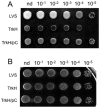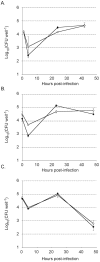Identification of trkH, encoding a potassium uptake protein required for Francisella tularensis systemic dissemination in mice
- PMID: 20126460
- PMCID: PMC2813290
- DOI: 10.1371/journal.pone.0008966
Identification of trkH, encoding a potassium uptake protein required for Francisella tularensis systemic dissemination in mice
Abstract
Francisella tularensis is a highly infectious bacterium causing the zoonotic disease tularaemia. During its infectious cycle, F. tularensis is not only exposed to the intracellular environment of macrophages but also resides transiently in extracellular compartments, in particular during its systemic dissemination. The screening of a bank of F. tularensis LVS transposon insertion mutants on chemically defined medium (CDM) led us to identify a gene, designated trkH, encoding a homolog of the potassium uptake permease TrkH. Inactivation of trkH impaired bacterial growth in CDM. Normal growth of the mutant was only restored when CDM was supplemented with potassium at high concentration. Strikingly, although not required for intracellular survival in cell culture models, TrkH appeared to be essential for bacterial virulence in the mouse. In vivo kinetics of bacterial dissemination revealed a severe defect of multiplication of the trkH mutant in the blood of infected animals. The trkH mutant also showed impaired growth in blood ex vivo. Genome sequence analyses suggest that the Trk system constitutes the unique functional active potassium transporter in both tularensis and holarctica subspecies. Hence, the impaired survival of the trkH mutant in vivo is likely to be due to its inability to survive in the low potassium environment (1-5 mM range) of the blood. This work unravels thus the importance of potassium acquisition in the extracellular phase of the F. tularensis infectious cycle. More generally, potassium could constitute an important mineral nutrient involved in other diseases linked to systemic dissemination of bacterial pathogens.
Conflict of interest statement
Figures









Similar articles
-
EmrA1 membrane fusion protein of Francisella tularensis LVS is required for resistance to oxidative stress, intramacrophage survival and virulence in mice.Mol Microbiol. 2014 Mar;91(5):976-95. doi: 10.1111/mmi.12509. Epub 2014 Feb 8. Mol Microbiol. 2014. PMID: 24397487 Free PMC article.
-
Glutathione provides a source of cysteine essential for intracellular multiplication of Francisella tularensis.PLoS Pathog. 2009 Jan;5(1):e1000284. doi: 10.1371/journal.ppat.1000284. Epub 2008 Jan 30. PLoS Pathog. 2009. PMID: 19158962 Free PMC article.
-
Asparagine assimilation is critical for intracellular replication and dissemination of Francisella.Cell Microbiol. 2014 Mar;16(3):434-49. doi: 10.1111/cmi.12227. Epub 2013 Nov 8. Cell Microbiol. 2014. PMID: 24134488
-
Loops and networks in control of Francisella tularensis virulence.Future Microbiol. 2009 Aug;4(6):713-29. doi: 10.2217/fmb.09.37. Future Microbiol. 2009. PMID: 19659427 Review.
-
The unraveling panoply of Francisella tularensis virulence attributes.Curr Opin Microbiol. 2010 Feb;13(1):11-7. doi: 10.1016/j.mib.2009.11.007. Epub 2009 Dec 23. Curr Opin Microbiol. 2010. PMID: 20034843 Review.
Cited by
-
Role of pathogenicity determinant protein C (PdpC) in determining the virulence of the Francisella tularensis subspecies tularensis SCHU.PLoS One. 2014 Feb 18;9(2):e89075. doi: 10.1371/journal.pone.0089075. eCollection 2014. PLoS One. 2014. PMID: 24558472 Free PMC article.
-
The pentose phosphate pathway constitutes a major metabolic hub in pathogenic Francisella.PLoS Pathog. 2021 Aug 2;17(8):e1009326. doi: 10.1371/journal.ppat.1009326. eCollection 2021 Aug. PLoS Pathog. 2021. PMID: 34339477 Free PMC article.
-
TrkA serves as a virulence modulator in Porphyromonas gingivalis by maintaining heme acquisition and pathogenesis.Front Cell Infect Microbiol. 2022 Nov 2;12:1012316. doi: 10.3389/fcimb.2022.1012316. eCollection 2022. Front Cell Infect Microbiol. 2022. PMID: 36405968 Free PMC article.
-
Role for cis-acting RNA sequences in the temperature-dependent expression of the multiadhesive lig proteins in Leptospira interrogans.J Bacteriol. 2013 Nov;195(22):5092-101. doi: 10.1128/JB.00663-13. Epub 2013 Sep 6. J Bacteriol. 2013. PMID: 24013626 Free PMC article.
-
Beyond Homeostasis: Potassium and Pathogenesis during Bacterial Infections.Infect Immun. 2021 Jun 16;89(7):e0076620. doi: 10.1128/IAI.00766-20. Epub 2021 Jun 16. Infect Immun. 2021. PMID: 33875474 Free PMC article. Review.
References
-
- Titball RW, Petrosino JF. Francisella tularensis genomics and proteomics. Ann N Y Acad Sci. 2007;1105:98–121. - PubMed
-
- Sjostedt A. Tularemia: history, epidemiology, pathogen physiology, and clinical manifestations. Ann N Y Acad Sci. 2007;1105:1–29. - PubMed
-
- Barker JR, Klose KE. Molecular and genetic basis of pathogenesis in Francisella tularensis. Ann N Y Acad Sci. 2007;1105:138–159. - PubMed
Publication types
MeSH terms
Substances
LinkOut - more resources
Full Text Sources
Medical
Miscellaneous

